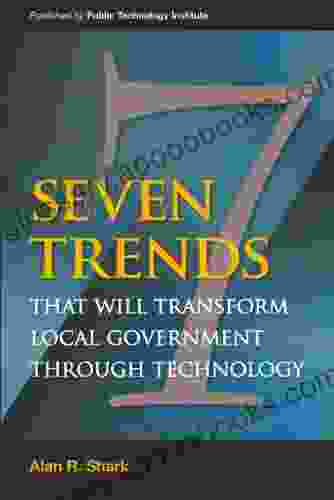Unveiling the Future: Seven Trends That Will Revolutionize Local Government with Technology

In today's fast-paced digital era, technology plays a pivotal role in shaping every aspect of our lives, including the way our local governments operate. As technology continues to advance at an exponential pace, local governments that embrace digital transformation will be the ones that thrive and better serve their citizens.
4.7 out of 5
| Language | : | English |
| File size | : | 25969 KB |
| Text-to-Speech | : | Enabled |
| Screen Reader | : | Supported |
| Enhanced typesetting | : | Enabled |
| Word Wise | : | Enabled |
| Print length | : | 172 pages |
| Lending | : | Enabled |
This comprehensive article delves into seven transformative trends that are poised to reshape the local government landscape in the years to come. From automation and artificial intelligence (AI) to blockchain and data analytics, these trends have the potential to empower cities and counties to achieve unprecedented levels of efficiency, transparency, and citizen engagement.
Trend 1: Automation and AI
Automation and AI are rapidly transforming the workforce across industries, and local government is no exception. Governments are increasingly leveraging these technologies to automate repetitive and time-consuming tasks, such as data entry, invoice processing, and customer service inquiries. This frees up valuable staff time to focus on more complex and strategic initiatives that directly benefit citizens.
For example, the city of Lexington, Kentucky, implemented an AI-powered chatbot named "Lexi" to assist residents with city services. Lexi provides information on everything from parking regulations to garbage collection schedules, reducing the need for phone calls and in-person visits.
Trend 2: Blockchain
Blockchain technology, the foundation of cryptocurrencies like Bitcoin, is gaining traction as a secure and transparent way to track and manage data. Local governments are exploring the use of blockchain to streamline various processes, including land registry, voting systems, and supply chain management.
For example, the city of Austin, Texas, is piloting a blockchain-based system for managing property records. This system will provide a secure and tamper-proof record of ownership, reducing the risk of fraud and streamlining the property transfer process.
Trend 3: Data Analytics
Data is essential for informed decision-making, and local governments are increasingly recognizing the value of leveraging data analytics to improve their operations and services. Data analytics tools can transform raw data into actionable insights, helping governments identify trends, optimize resource allocation, and make better-informed policies.
For example, the city of San Francisco uses data analytics to monitor traffic patterns and identify congestion hotspots. This information helps the city plan new infrastructure projects and implement traffic management strategies to improve mobility for residents.
Trend 4: Cloud Computing
Cloud computing offers a scalable and cost-effective way for local governments to access and manage their data and applications. By moving to the cloud, governments can reduce their IT infrastructure costs, improve data security, and increase flexibility.
For example, the state of California has adopted a cloud-first policy, requiring all state agencies to prioritize cloud solutions for their IT needs. This move is expected to save the state millions of dollars and enhance the security of its data.
Trend 5: Smart Cities
The concept of smart cities is gaining momentum around the world, with local governments leveraging a range of technologies to improve the quality of life for their citizens. Smart cities utilize sensors, data analytics, and other technologies to optimize infrastructure, transportation, energy consumption, and environmental sustainability.
For example, the city of Copenhagen has become a beacon of smart city innovation. The city has implemented a comprehensive network of bike-sharing stations, traffic monitoring systems, and energy-efficient buildings to enhance the livability and sustainability of its urban environment.
Trend 6: Citizen Engagement
Technology is also transforming the way local governments engage with their citizens. Social media, mobile applications, and online platforms are providing new channels for residents to voice their concerns, provide feedback, and participate in decision-making processes.
For example, the city of Chicago has launched a mobile app called "311" that allows residents to report problems, submit service requests, and receive updates on city services. This app has significantly improved communication between the city and its citizens, fostering a more responsive and inclusive government.
Trend 7: Open Data
The open data movement is gaining traction in the public sector, with local governments recognizing the benefits of making their data publicly available. Open data promotes transparency, empowers citizens with information, and fosters innovation by enabling developers and researchers to create new applications and services.
For example, the city of New York maintains a vast open data portal that provides access to a wide range of data, including transportation patterns, crime statistics, and building permits. This data has been used to create new mobile apps, improve public safety, and inform policy decisions.
The future of local government is being shaped by the transformative power of technology. The seven trends explored in this article provide a glimpse into the exciting possibilities that lie ahead for cities and counties that embrace digital transformation.
By leveraging automation, AI, blockchain, data analytics, cloud computing, smart city solutions, citizen engagement platforms, and open data initiatives, local governments can empower their citizens, improve service delivery, and create more sustainable and equitable communities.
As technology continues to advance at an unprecedented pace, local governments that stay at the forefront of innovation will be the ones that succeed in the 21st century and beyond. By embracing these transformative trends, local governments can unlock the full potential of technology to build a brighter future for their communities.
4.7 out of 5
| Language | : | English |
| File size | : | 25969 KB |
| Text-to-Speech | : | Enabled |
| Screen Reader | : | Supported |
| Enhanced typesetting | : | Enabled |
| Word Wise | : | Enabled |
| Print length | : | 172 pages |
| Lending | : | Enabled |
Do you want to contribute by writing guest posts on this blog?
Please contact us and send us a resume of previous articles that you have written.
 Book
Book Novel
Novel Page
Page Chapter
Chapter Text
Text Story
Story Genre
Genre Reader
Reader Library
Library Paperback
Paperback E-book
E-book Magazine
Magazine Newspaper
Newspaper Paragraph
Paragraph Sentence
Sentence Bookmark
Bookmark Shelf
Shelf Glossary
Glossary Bibliography
Bibliography Foreword
Foreword Preface
Preface Synopsis
Synopsis Annotation
Annotation Footnote
Footnote Manuscript
Manuscript Scroll
Scroll Codex
Codex Tome
Tome Bestseller
Bestseller Classics
Classics Library card
Library card Narrative
Narrative Biography
Biography Autobiography
Autobiography Memoir
Memoir Reference
Reference Encyclopedia
Encyclopedia Diana Finlay Hendricks
Diana Finlay Hendricks Dianne Marcum
Dianne Marcum Nikol G Alexander Floyd
Nikol G Alexander Floyd Dennis Munday
Dennis Munday Denise Von Glahn
Denise Von Glahn Suzuhito Yasuda
Suzuhito Yasuda Dennis Haugh
Dennis Haugh Jimmy Newell
Jimmy Newell Diana Rock
Diana Rock Jim Krosschell
Jim Krosschell Victoria Goddard
Victoria Goddard Richard M Perloff
Richard M Perloff Toni Jensen
Toni Jensen Dennison Berwick
Dennison Berwick Ts Snow
Ts Snow Mike Cox
Mike Cox Tim Raine
Tim Raine Jacquelyn Jaie Fourgerel
Jacquelyn Jaie Fourgerel Linda W Braun
Linda W Braun Delphia
Delphia
Light bulbAdvertise smarter! Our strategic ad space ensures maximum exposure. Reserve your spot today!

 Ralph EllisonUnveiling the Secrets of Earth's Climate: Exploring ISSN 56: Global Physical...
Ralph EllisonUnveiling the Secrets of Earth's Climate: Exploring ISSN 56: Global Physical... Oliver FosterFollow ·12.7k
Oliver FosterFollow ·12.7k Jeremy MitchellFollow ·7.5k
Jeremy MitchellFollow ·7.5k Ruben CoxFollow ·8.2k
Ruben CoxFollow ·8.2k Edgar CoxFollow ·19.1k
Edgar CoxFollow ·19.1k Edward ReedFollow ·6.5k
Edward ReedFollow ·6.5k Jim CoxFollow ·17.3k
Jim CoxFollow ·17.3k Italo CalvinoFollow ·6k
Italo CalvinoFollow ·6k Arthur C. ClarkeFollow ·4.7k
Arthur C. ClarkeFollow ·4.7k

 Clarence Mitchell
Clarence MitchellCollection Of Handcrafted Plants For The Blackest Of...
Do you have a black...

 Edgar Hayes
Edgar HayesClassic Racing Mystery From The King Of Crime
Agatha Christie, the...

 Demetrius Carter
Demetrius CarterLafayette: Courtier to Crown Fugitive, 1757-1777
The Marquis de...

 Jared Powell
Jared Powell30 Gorgeous Sweaters, Cardigans, Hats, Toys & More:...
Immerse Yourself...
4.7 out of 5
| Language | : | English |
| File size | : | 25969 KB |
| Text-to-Speech | : | Enabled |
| Screen Reader | : | Supported |
| Enhanced typesetting | : | Enabled |
| Word Wise | : | Enabled |
| Print length | : | 172 pages |
| Lending | : | Enabled |














